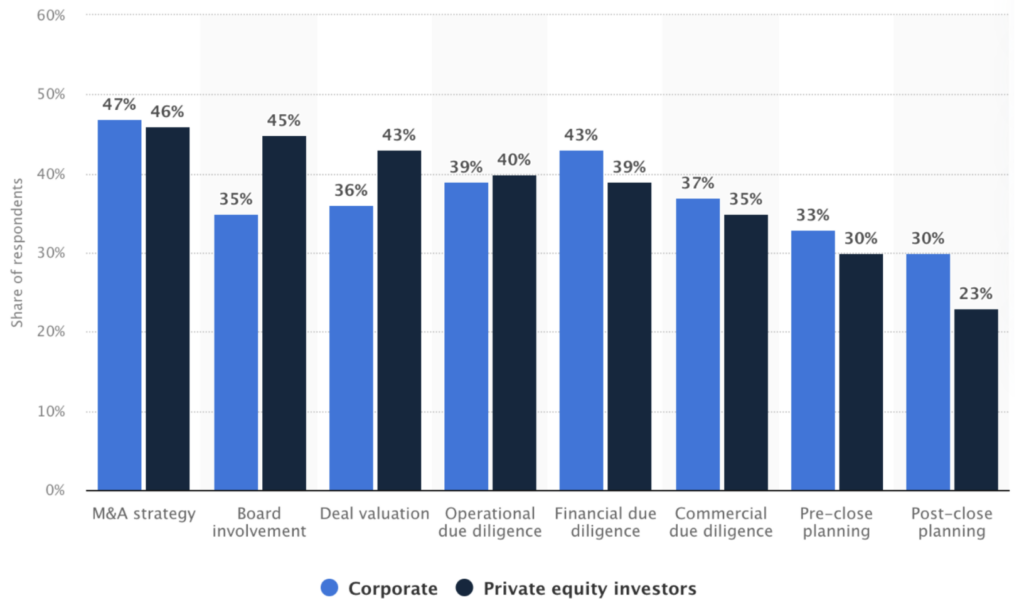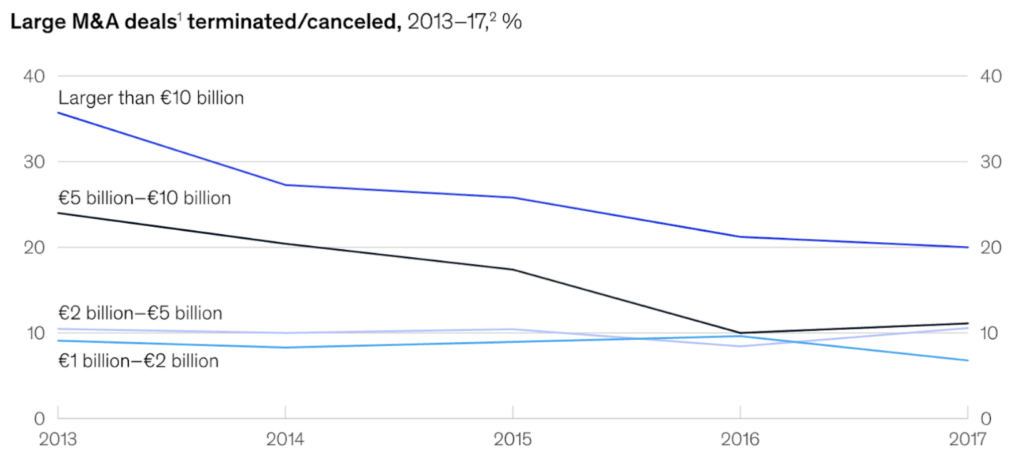Mergers and acquisitions (M&A) are one of the fastest ways for a company to achieve growth and enter new markets. More and more companies are choosing M&A as a transformational tool every year: in 2022 there were almost 50,000 M&A deals worldwide and about 28,000 M&A deals in H1 2023.
However, not all deals end successfully. On the contrary, the number of failed deals is also striking.
So, why do acquisitions fail sometimes, and what is a common reason for the failure of an acquisition? Let’s find out in this article.
The stark reality: The high failure rate
According to research conducted by McKinsey & Company, about 10% of all large mergers and acquisitions are canceled every year. This number is quite significant, considering that about 450 of such deals are announced annually.
However, the number might be even higher, considering the information presented by Roger L. Martin in the June 2016 issue of the Harvard Business Review, according to whom “M&A is a mug’s game, in which typically 70–90% of deals fail.”
Indeed, mergers and acquisitions quite often fail, no matter the size of the transaction. For example, one of the most famous business mergers and the biggest M&A failure in history was the $165 billion deal between AOL and Time Warner. Among the main reasons for failure, M&A practitioners indicate a lack of vision of post-integration steps, cultural clashes, and misreading of the current market state. All of those issues could be solved with proper prior analysis.
Why proper analysis matters
To put it briefly, an adequate M&A analysis allows an acquiring company to assess the potential of the target company. Financial and performance analysis allows for finding the weak spots that could impact the transaction, as well as strong points that could bring potential benefits to the companies combined.
Thus, M&A analysis is a powerful risk assessment tool that helps two companies evaluate the transaction’s potential and build a strong business model based on gained insights.
Top 11 reasons why mergers and acquisitions fail most often
Now, let’s get to the point and review the most common reasons for the failure of mergers and acquisitions.
1. Unclear goals and timelines
According to a survey conducted by Statista in 2021, most respondents indicate that a clear M&A strategy is the most important factor for achieving a successful M&A in the U.S.

Thus, lack of proper strategic planning is the most common reason why most mergers and acquisitions fail.
Sometimes, companies rush an M&A deal when there’s an opportunity to acquire a competitor or to gain a bigger market share. However, rushing often results in unrealistic expectations and, thus, a failed transaction. Before entering into a transaction, both companies should clearly understand the acquisition objectives and assess the potential synergies it can bring.
2. Poor due diligence
Sloppy or careless due diligence processes is another common reason why the majority of mergers and acquisitions fail.
According to Bain’s 2020 Global Corporate M&A Report, more than 60% of executives indicate that poor due diligence is the main reason for deal failure.
Due diligence is an integral part of the M&A process that allows an acquiring company to investigate the documentation, legal aspects, and internal processes of the to-be-acquired company to help avoid surprises. On the other hand, due diligence is also a great chance for target companies to ensure they’re fully prepared for the acquisition.
Proper due diligence ensures a smooth transaction by minimizing possible risks. Conversely, lax due diligence may result in the deal failure and great financial losses.
3. Overpaying
The McKinsey & Company analysis of about 2,500 deals conducted between 2013 and 2018 showed that the larger the transaction, the more likely it is to fail.

Often, companies become too focused on the potential benefits a deal may bring and overlook its real value. This often results in a failed transaction and financial loss.
One of the clearest and infamous examples of an overpaid and failed M&A transaction is the historic and already-mentioned $165 billion deal between AOL and Time Warner.
4. Lack of proper communication
This relates to poor communication both between the two companies engaging in the deal and between the senior management and key team members.
Communication breakdowns between the sell- and buy-side lead to different visions of the deal objectives. Additionally, poorly communicated deal objectives by the senior executives leaves key team members confused and might lead to misunderstanding of the combined company’s goals. This, in turn, results in executing the wrong goals.
5. Cultural clashes
When two companies have completely different cultures, it might be difficult to gain a cultural fit during post-merger integration.
Different cultures, values, and operational styles lead to confrontations among company staff. This results in poor cooperation and impacts the overall company’s performance.
According to Deloitte, cultural differences are the reason for 30% of failed integrations. This was one of the main reasons for the failure of the $35 billion deal between Sprint and Nextel in 2005. Sprint had a more bureaucratic style of management, while Nextel had a more entrepreneurial spirit. The incompatibility of the two companies was also evidently manifested by the fact that they kept two separate headquarters.
6. Operational difficulties
Just like with culture, the operational styles of two companies entering a transaction also matter.
When two companies have different approaches to operations, it can lead to operational inefficiencies and M&A challenges.
Operational differences can include challenges related to integrating different corporate processes, technologies, and management styles. These differences can contribute to the failure of M&A deals by causing disruptions, decreasing employee morale, and affecting the overall performance of the merged entity.
7. Lack of management involvement
Often, company senior managers and leadership teams choose to let professional advisors oversee the transaction and address the deal issues.
However, management involvement helps a company to close a deal successfully. This is because company owners and senior managers have a better understanding of the deal objectives and, thus, build an atmosphere of trust throughout the company teams actively engaged in the integration process.
8. Regulatory issues
McKinsey & Company research shows that out of 345 large M&A deals announced between 2013 and 2020, 47 of them (14%) were canceled because of antitrust or regulatory reasons. As of 2023, there were 3 merger complaints filed due to the antitrust laws so far, according to Bloomberg.
These are the external factors that greatly impact a deal’s success. However, thorough due diligence and prior analysis help to avoid regulatory difficulties.
9. Poor post-merger integration
After a deal’s closure, the integration process begins. Often, companies underestimate the importance of post-merger integration, which results in poor post-acquisition management and poor execution of the deal’s objectives.
Instead, an acquiring firm and a target company should have a clear integration plan, which specifies how the companies’ workforce, projects, products, and internal processes will be distributed and shared.
10. High recovery costs
The complexity of the post-merger integration process typically leads to high recovery costs, which are sometimes beyond the companies’ capacity. As a result, the deal fails.
When assessing the transaction and building a strategy, companies should take into account the post-merger integration period and the costs it might incur. This is because a newly formed company might need to invest in new processes or systems. Additionally, there might also be layoffs that could lead to higher costs.
11. Synergy overestimation
Overestimated synergies go together with overpaying and are what leads to the latter.
Often, companies become too focused on the potential synergies a deal can bring without proper analysis and, thus, might not notice certain issues a target company lacks. This results in overpaying and possible deal failure.
Summing up
Despite being a powerful transformation tool for companies, M&A is not always successful. Moreover, the numbers prove M&A deals quite often fail: about 10% of all large transactions are canceled every year. Mergers and acquisitions often fail because of many factors. This article has addressed the following:
- Unclear goals and timelines
- Poor due diligence
- Overpaying
- Lack of proper communication
- Cultural clashes
- Operational difficulties
- Lack of management involvement
- Regulatory issues
- Poor post-merger integration
- High recovery costs
- Synergy overestimation
Keep up with the M&A Community blog to learn how to close a deal successfully and avoid failure.


